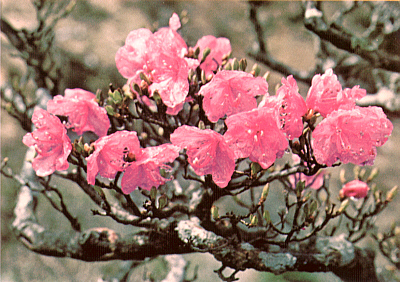QBARS - v31n1 Cheju, Another Yakushima
Cheju, Another Yakushima
by Warren Berg , Kent, Washington

|
|---|
R. mucronulatum on Cheju Island Photo by Warren Berg |

|
|---|
R. mucronulatum Cheju dwarf form Photo by Warren Berg |
The island of Cheju, Korea's only island province, is almost a twin to Japan's Yakushima Island. They are both about the same size and height, and are located approximately 60 miles south of their respective countries. Both enjoy semi-tropical climate (at sea level) and their plants and landscapes are entirely different from those of the mainland.
The beauties of Cheju range from lofty Mt. Halla (over 6000'), an extinct volcano and the highest mountain in South Korea, to the famed women divers who make their living by gathering seafood and other marine products from the depths of the ocean, even in the winter. Cheju also claims the longest cave in the world, and more than 360 small extinct volcanoes.
This island province is also known by the name of "Sando do", which means an island abundant in three things, rocks, women, and wind. It is also lacking three things, thieves, beggars, and gates. The customs and culture of the people are quite different from other parts of Korea.
In May of 1976, Mr. Hideo Suzuki, my wife and I visited this unique island to search for the illusive rhododendron. We were met with much enthusiasm at the Cheju airport. Even the local papers and radio station made a fuss of our being the first rhododendron explorers from the United States and Japan to visit their island.
The first two days on Cheju were spent sight seeing and getting acquainted. We then headed for the top of Mt. Halla, where we spent three days collecting and photographing this wild and beautiful mountain. At this time of the year, it normally rains every day and, although, we were drenched while climbing the mountain, the following two days were very nice.
Among the 1700 species of plants reportedly growing here, we found three rhododendrons, R. weyrichii , R. poukhanense , and the prize we most sought, a very dwarf form of R. mucronulatum . This was found in abundance, growing on Mt. Halla, from the 4500' level to the top. R. aureum and R. dauricum have been reportedly found also, but we were unable to locate either one. The top of Mt. Halla is a large crater with a volcanic lake in the depression. The rim of the crater, which was covered with dwarf R. mucronulatum in full bloom, was a gorgeous sight.
Although there are pineapples and oranges growing at sea level on the southern part of the island, Mt. Halla is very alpine, with areas of heavy woods, rocks and water falls. These have been artistically combined with the help of strong winds and heavy snows to form a picture of unforgettable beauty. No doubt the harsh elements account for the prostrate growth habit of all trees and shrubs found here, just as it does on the top of Yakushima.
We were very impressed with the tremendous variety of plant material and were able to collect some fine specimens. These selected dwarf mucronulatum were of fine color, and should be very hardy. They are now being grown by the Rhododendron Species Foundation, and will be made available in the near future. Also, the collected seed may be obtained through the A.R.S. seed exchange.
If there is a moral to this report, I believe it is the fact that there are yet many other new species of rhododendron yet to be found in the hiding places of the world.

